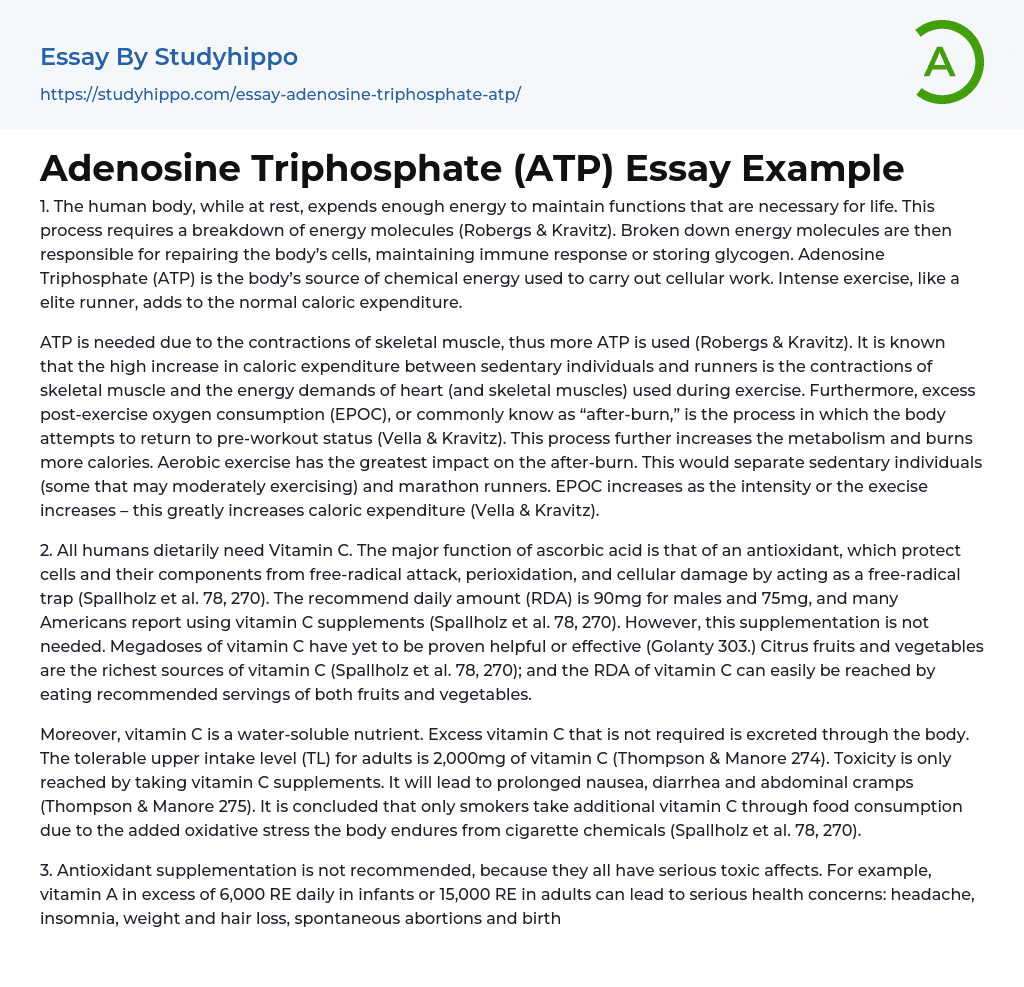While at rest, the human body uses energy to maintain essential life functions by breaking down energy molecules (Robergs & Kravitz). This breakdown serves multiple purposes such as cell repair, immune response support, and glycogen storage. Adenosine Triphosphate (ATP) provides the necessary chemical energy for cellular activities. Intense exercise, such as that performed by elite runners, leads to an increase in calorie expenditure beyond usual levels.
Robergs & Kravitz state that the contractions of skeletal muscle during exercise require ATP, leading to increased usage of ATP. The higher caloric expenditure in runners compared to sedentary individuals is due to the contractions of skeletal muscle and the energy demands of the heart and skeletal muscles during exercise. According to Vella & Kravitz, excess post-exercise oxygen consumption (EPOC), also known as
..."after-burn," helps the body return to its pre-workout state. This process boosts metabolism and promotes calorie burn. The after-burn effect is most notable in aerobic exercise and distinguishes between sedentary individuals, including those who engage in moderate exercise, and marathon runners. EPOC increases with exercise intensity, resulting in a significant rise in caloric expenditure.
2. Vitamin C is necessary for human dietary requirements as it serves as an antioxidant, shielding cells and their components from harm caused by free radicals, peroxidation, and cellular damage through its ability to trap free radicals (Spallholz et al. 78, 270). The recommended daily intake (RDA) of vitamin C is 90mg for males and 75mg for females. Despite the fact that many Americans rely on vitamin C supplements (Spallholz et al. 78, 270), taking these supplements in high doses is unnecessary due to the lack of proven
effectiveness (Golanty 303). Citrus fruits and vegetables are the primary sources of vitamin C (Spallholz et al. 78, 270), and by consuming the recommended servings of both fruits and vegetables, one can easily meet the RDA for vitamin C.
Furthermore, the body gets rid of excess amounts of vitamin C because it is a water-soluble nutrient. Thompson & Manore (274) state that adults should not consume more than 2,000mg of vitamin C, which is known as the tolerable upper intake level (UL). According to Thompson & Manore (275), taking too many vitamin C supplements can be harmful and lead to extended periods of nausea, diarrhea, and abdominal cramps. Moreover, Spallholz et al.'s research (78, 270) suggests that only smokers need extra vitamin C due to the additional oxidative stress caused by cigarette chemicals.
3. It is recommended to avoid antioxidant supplementation because it may have potential toxic effects. Consuming excessive amounts of vitamin A, such as more than 6,000 RE daily in infants or 15,000 RE in adults, can lead to various health problems like headaches, insomnia, weight and hair loss, spontaneous abortions, and birth defects (Spallholz et al 65). Similarly, high doses of vitamin E can worsen coagulation issues in individuals with vitamin K deficiency and hinder the absorption of vitamin A (Spallholz et al 72). Unlike vitamin C, these antioxidants are not easily eliminated but instead accumulate in fatty tissues which increases the risk of reaching toxic levels.
Including fruits and vegetables in your diet is an easy method to obtain antioxidants like vitamin A, vitamin E, vitamin C, and Beta-Carotene. Vitamin E can be found abundantly in nuts, vegetable
oils, and wheat germ (Spallholz et al 65, 72). There is no necessity for relying on supplements or being concerned about deficiencies since they are uncommon in developed nations.
In low dosages, antioxidant supplementation can be beneficial by acting as a sponge to absorb cell-destroying free radicals. It oxidizes itself when reacting with these toxic species (Spallholz et al. 270). Different vitamins have different protective roles within the cells: vitamin A protects the cell wall and membranes, while vitamin C safeguards the fluid-like cytoplasm. To prevent and stop cell damage, it is important to consume sufficient amounts of these essential nutrients (Spallholz et al. 270). Extensive damage caused by free radicals has been associated with the development of various cancers and other significant health concerns.
- Psychological Trauma essays
- Physical therapy essays
- Cold essays
- Bacteria essays
- Biotechnology essays
- Breeding essays
- Cell essays
- Cell Membrane essays
- Cystic Fibrosis essays
- Enzyme essays
- Human essays
- Microbiology essays
- Natural Selection essays
- Photosynthesis essays
- Plant essays
- Protein essays
- Stem Cell essays
- Viruses essays
- Action Potential essays
- Blood essays
- Body essays
- Brain essays
- Childbirth essays
- Eye essays
- Glucose essays
- Heart essays
- Human Physiology essays
- Immune System essays
- Kidney essays
- Muscle essays
- Nervous System essays
- Neuron essays
- Poison essays
- Puberty essays
- Sense essays
- Skeleton essays
- Skin essays
- Addiction essays
- Anatomy and Physiology essays
- Biodegradation essays
- Cancer essays
- Dental Care essays
- Disability essays
- Disease essays
- Disorders essays
- Health Care essays
- Infectious Disease essays
- Inquiry essays
- Intelligence Quotient essays
- Lung Cancer essays




